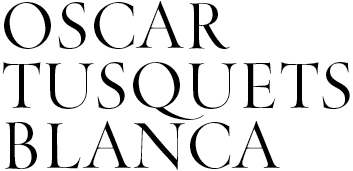25 kind friends
March 2008
25 kind friends
Varius is 25 years old, and 25 friends have very generously agreed to be photographed with it. I’ve written a short and informal text about each of them and, after noting their profession, I’ve taken the liberty of adding a personal comment. Since they are friends, I hope they will forgive me the odd indiscretion...
Oscar Tusquets Blanca
Antonio, Beatriz, Beth, Bibianna, Boris, Eduardo, Enrique, Fernando A., Fernando S, Gillo, Ingo, Jaume, Javier, Joana,
Jordi, Jorge H., Jorge P., Josep, Leopoldo, Mónica, Nani,
López García—in spite of being one the world’s most highly-regarded and highly-valued artists—is a heck of a painter and sculptor. When he went to the School of Fine Arts in Madrid he was a child prodigy and they called him Antoñito. I think, although he’s grown up, we should go on calling him that, like Antonello da Messina. In Antoñito’s home and studio there are several Varius, whose metal legs, quite casually, he has cut short. When he saw how flabbergasted I was he said, “It’s just that María and I are so short…”.
de Moura is a publisher. She heads Tusquets Editores, a now-prestigious publishing company which we founded together, starting from nothing with minimal resources, 40 years ago, in that legendary year 1968. She was my first wife and is still a wonderful friend. She’s Brazilian, although being a diplomat’s daughter she lived in many places around the world, always studying in French lycées. Like a good Rio de Janeiran, she dances the samba brilliantly, though we fell in love dancing rock and roll.
Galí is an architect and, at present, president of FAD, the Foment de les Arts i del Disseny (or Association for Fostering the Decorative Arts) in Barcelona. Although I already knew her—because of friendship with her family, with a long tradition in the applied arts, because of some pieces of furniture design and because of her having appeared, very pretty, in a TV ad by Toni Bernat—it was not until she attended my courses at the Barcelona School of Architecture that I was able to appreciate her talent. I seem to remember we gave her very high marks.
Bibiana Go up
Fernández is an actress—one of Pedro Almodóvar’s muses—but she’s also a broadcaster, dancer, model… and she was a great stripper when we discovered her years ago, with Leopoldo Pomés, in a club in Barcelona, although then she wasn’t called Bibiana. She’s an enchanting woman, crazy and unconventional, but overwhelmingly professional. When she saw how concerned I was about how seriously she took posing for this photograph—a job she usually demands a lot of money for—she said to me, “Oscar, if I don’t do it like this, I get bored”.
Izaguirre is a very famous writer and broadcaster in the Hispanic world (a world with a reputation for machismo, but which has accepted the openness with which he has declared his gay pride with ease and tremendous affection). Boris is a lover and great connoisseur of architecture and design. The main male character in his latest novel is Gio Ponti, and when he showed me a glamorous photo of Lana Turner he commented, “The best thing about this is the Saarinen chair you can see behind”.
Mendoza is a writer, a writer who is not only successful but also talented. Eduardo is a Barcelona Gentleman, one of the few who remain to us, with a highly-tuned sense of humour (thus may we interpret the location and the journal that appears in the photo). He is also my official corrector (a luxury I can afford), although he has written that he thinks I’m incorrigible.
Enrique Go up
Vila Matas is a writer. A writer and nothing but a writer. When we were young and we designed illegible but supremely interesting covers for him, I would have said he was a troublesome writer; later on, a cult writer; now, that he’s a successful writer. Successful and very good, even when he writes strange and highly personal articles in the papers.
Amat is a high priest of world design. You mustn’t fail to visit Vinçon—his store that takes up half a block of one of the most expensive urban areas in Europe—whether you’re a tourist interested in design or a local who wants to solve some decor problem at home in the least ugly possible way. Fernando always takes pains to point out that he doesn’t keep a fashion store (like Colette) but a warehouse for solving problems (like Servicio Estación). His criteria are so radical that all us designers are afraid of him.
Savater is a philosopher, novelist, playwright, university professor, a fine drinker and a keen horse-racing enthusiast. On top of that, he’s a moralist, a friend to his friends and—although he wouldn’t like me to mention it—a brave man (whenever we have met a pair of body-guards have always accompanied us discretely). And unlike this writer, he’s sincerely concerned about the problems of society.
Dorfles is a brilliant theoretician of architecture, design and mass art. He is a key figure in the golden age of Italian design, an author whose works we started to issue almost half a century ago in my sister Esther’s publishing company, and an old man with the vitality and curiosity of a child. This photo was taken not long ago, when he came to chair the jury of the ADI FAD design prizes. While the jury were discussing their verdicts he constantly asserted his well-founded opinions with a convincing passion.
Ingo Go up
Maurer is a designer. It’s really hackneyed to say he’s the “master of light”, but… that’s what he is. Nobody else can design lamps like his: he uses the latest high-tech to make objects full of poetry. Together we have made fantastic pieces specifically conceived for an architectural space. In his catalogue he has a book/lamp which he was so kind as to name after me; granted, it does look a bit like one of mine…
Vallcorba is a publisher, a highly-sophisticated publisher who’s just as concerned about an ill-placed semi-colon as he is about disproportionate line spacing. He publishes in Spanish and is the best publisher in Catalan (although he has never received any recognition or financial support from the public authorities). He is the most Catholic of my friends. He says he converted definitively after listening to a mass by Bach. He requires his partners to keep silent for half an hour every morning while he listens to that music. Perhaps that’s why those relationships never crystallise.
Mariscal is a bit like me: I mean no one’s quite sure whether he’s a graphic designer, an industrial designer or a designer of monuments, whether he’s a painter or an illustrator or a film director or a playwright. What is beyond doubt is that he’s an artist who transmits a terrific joie de vivre, something which is very unusual these days. Javier and Mónica have twins, about two years older than ours. When Eva was on the point of giving birth we visited them to get a practical class in situ. The class was so terrifying that it was just as well we were too late change our minds…
Bonet has been, for several years, the editor and moving spirit of the Spanish edition of Marie Claire. She’s an authority on fashion but also writes books and articles on other subjects, often related to women’s issues. Every year she organises the Prix de la Mode in the French embassy in Madrid, far and away the country’s most glamorous party: vaut le voyage.
Jordi Go up
Labanda is a world-famous illustrator but also a fashion designer and a passionate observer of everything new. Particularly design, whether fashion, architecture, objects or furniture. Strolling together through the little world of the Fiera di Milano—Corso Como included—is a highly interesting experience: we’re interested in the same things (including Carlo Mollino), although we see them so differently.
Herralde is a publisher—he’s published almost all my books—and what he finds most entertaining, as you can tell if you read his autobiographical writings, is being a publisher. He even enjoys himself going to Frankfurt, which is saying something. We met when we were kids in an almost-deserted Platja d’Aro and we’re still friends today; perhaps because, having been a publisher myself, I don’t blame him because my books aren’t in the kiosk at the airport, or that I don’t have an agent.
Pensi is a designer (an industrial designer, I would say if I believed in the term) but, like everyone I find interesting, he does other things, such as composing music with plenty of determination and ambition. He’s Argentinean, one of those who stayed in Barcelona for the long haul and who has enriched, apart from psychiatry, design in the mother country. His chair is one that has become a classic of Spanish design. So to see him coming down the stairs of his studio with the Varius in his arms (although it’s moved a little) is really quite a compliment.
Josep
Font is a fashion designer. Josep is the only Spanish designer whose haute couture is paraded on the catwalks of Paris. He is a perfectionist who thrills to precious materials and the most delicate craftsmanship. His models parade solemnly, as dignified as princesses, before he appears, nervous, deeply embarrassed by the enthusiastic applause, looking down at the floor, in his T-shirt and jeans.
Leopoldo Go up
Pomés is a photographer, but also a publicist (though he’s just given that up), film-maker and founder of restaurants as well as being a specialist in feminine beauty. He has a way of paying saucy compliments to women that is very much his own, not at all Andalusian, very Catalan. He looks at them fixedly and says, “Keep still, don’t move! You can’t imagine how the light is caressing you at this moment”, and if he has it to hand, he pulls out his little digital camera and takes a photo, very often a fantastic one. Here he is in the gardened courtyard I personally reinterpreted in his house in the district of Gràcia in Barcelona.
Boada now works with the Istituto Europeo di Design, but in my view she has been our country’s most spectacular model. I still remember how, in the Flash bar in Barcelona, I was with the painter Luís Marsans, and we gazed enraptured at that eighteen-year-old who was rumoured to be a student at the Lycée Français who was beginning to take her first steps as a model. Later on, when I saw her parading clothes for Toni Miró, I had no doubt as to how far she’d go (although she’s never let her success and popularity go to her head).
Marquina is a carpet maker and designer, one of the most famous and creative in the world. Her company, a model business, is staffed entirely by women; in other words she fails to comply with the rule of parity imposed by the political correctness that is the order of our day. Her father is Rafael, who designed a cruet that today we all regard as the crowning opus of contemporary Spanish design.
Ouka Leele
Bárbara Allende Gil de Biedma is a photographer. A somewhat unconventional photographer, as she lights her photos with surreal colours, dresses her models up extravagantly and, at times, her talents overflow into other disciplines like a richly undulating wave in the ria of Bilbao. Bárbara is an artist in the widest sense of the word and a charming woman, just as beautiful as she looks in this photo
RafaGo up
Moneo, as everyone knows, is an architect. Architect and maestro of architects. His time at the Barcelona School of Architecture left an indelible mark on a generation of Catalan architects, that affected even their way of speaking. And the same thing happened later on in Madrid. Many of the architects who are calling the shots today have worked in his practice. But what bothers Rafa most at the moment is the bouquet of the wine he’s been so keen to produce.
Novell is an actress (always excellent, famous when she appears on TV) and theatre director. In contrast with the works she stages—the easiest and most entertaining of which has been Oh les Beaux Jours, by Samuel Beckett—she’s overwhelming cheerful and entertaining by nature. A cheek-to-cheek dance with her a few years ago nearly wrecked my marriage of the time.
Santi Go up
Dexeus is a gynaecologist, another member of the dynasty of distinguished doctors who have given their name to a famous Barcelona clinic.
Santi delivered our twins. Contradicting my wife—who would have preferred a caesarean delivery, anaesthetised and unaware of anything—he insisted on a traditional birth: he inserted his expert hand and, under the dubious gaze of a couple of young doctors, he withdrew first Valeria and shortly afterwards Luca. He told us how scandalised his father would have been if he could have known how many unnecessary caesareans are performed these days.
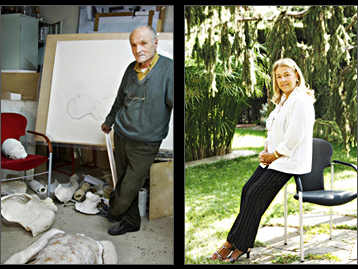
Antonio López and Beatriz de Moura
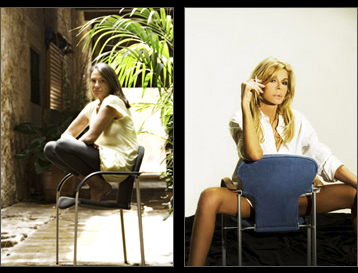
Beth Galí and Bibiana Fernandez.
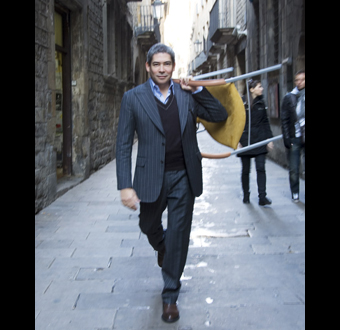
Boris Izaguirre
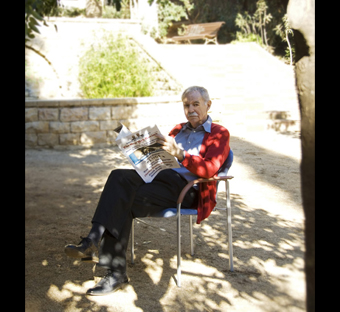
Eduardo Mendoza
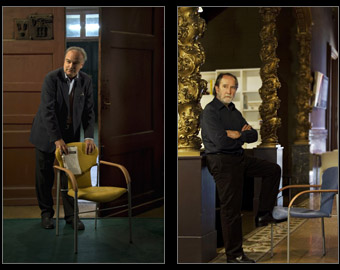
Enrique Vila Matas and Fernando Amat
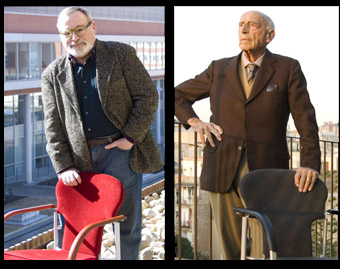
Fernando Sabater and Gillo Dorfles
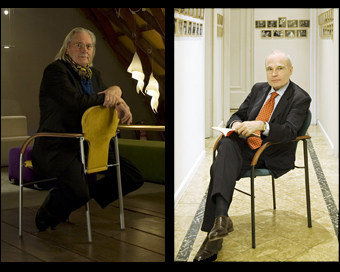
Ingo Maurer and Jaume Vallcorba
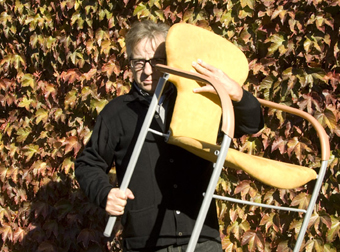
Javier Mariscal
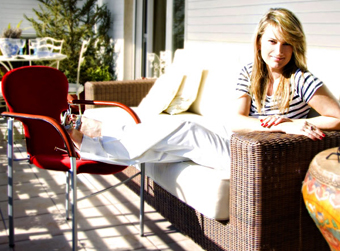
Joana Bonet
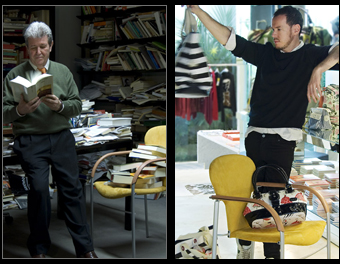
Jorge Herralde and Jordi Labanda
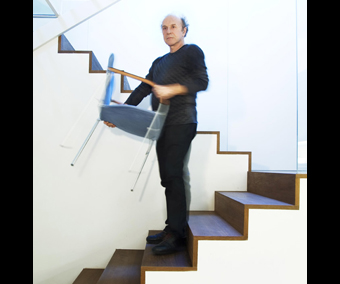
Jorge Pensi
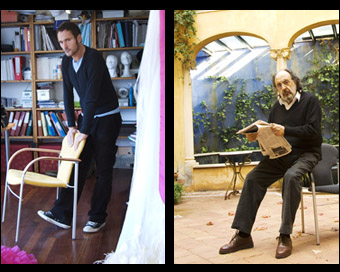
Josep Font and Leopoldo Pomés
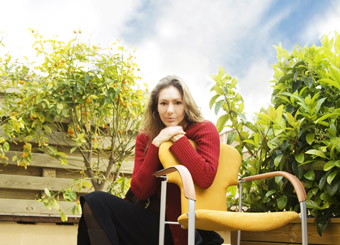
Mónica Boada
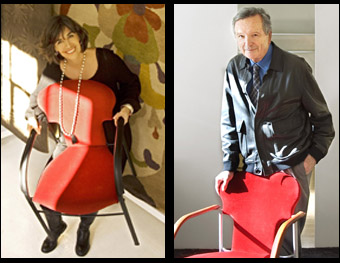
Nani Marquina and Rafael Moneo
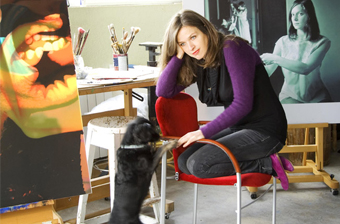
Ouka Lele
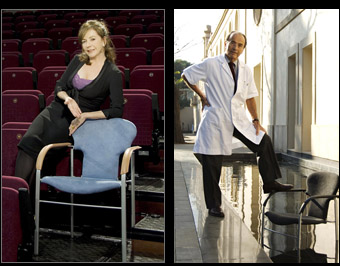
Rosa Novell and Santiago Dexeus
